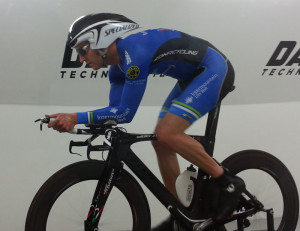
Layne Christensen made the inception and completion of his Darko Technologies wind tunnel look way too easy. From his perspective, it was simply one of the ideas over the course of his entrepreneurial career that made sense. So, he made it happen.
Built almost entirely by his own hands, the careful study and networking that led to his decision, followed by thousands of hours of labor, add up. But from the outside, the tunnel came to fruition from nowhere, in a place at once unlikely and logical.
A couple of months ago, a coaching client of mine read about the completion of the tunnel in a small Ogden, Utah, online publication and sent me the link. Some weeks later I received a call from Christensen, who invited me to a wind tunnel training session that would actually be led my longtime aerodynamics mentor, John Cobb.
Cobb requires no introduction here, which was the reason Christensen had sought out his advice early on, while still contemplating the feasibility and appeal of the project. The two met for a consultation over dinner — which Cobb paid for, remembers Christensen. Cobb was encouraged by Christensen’s thorough pondering of all technical and economical considerations, as well as his past success as an entrepreneur. Cobb encouraged Christensen to go for it.
Cobb also pointed Christensen to other industry experts who could advise him in order to ensure that the tunnel became a worthwhile venture. That was Christensen’s first prerequisite: It had to be a tunnel that could be considered one of the best in the country, one that delivered on its promises of precise function and usable data.
Now, a year later, the tunnel is complete. Christensen’s vision and objectives are already being validated by motorized and human powered vehicle and athlete testing, for which aerodynamics are a top priority.
Specifically for cyclists and triathletes around the world, the Darko Technologies wind tunnel adds another resource therefore opportunity for the advancement of personal, product and athletic program aerodynamics study and validation. Following a two-day seminar earlier this year for coaches, bike shops and fitters led by Cobb and University of Utah’s Jim Martin, the facility is now open to athletes as a practical and scientific resource.
Which leads us back to Cobb and those he trains to become competent aerodynamic technical advisers… Cobb has made a career out of the common sense application of theory and experience through practice.
Cobb establishes aerodynamic drag values via repeated timed runs at various angles – or yaw – in the tunnel, relying on the numbers generated by precision instrumentation in this well controlled environment. They are comparative values which assess from one test run to another which equipment and positional changes progressively lead to improvements, all in real-time.
There has been a lot of talk regarding CdA or “Drag Area” and how it can provide many of the benefits of aerodynamics study outside of a wind tunnel. That was one of the topics that Martin presented during the seminar, including its scientific and mathematical foundations. Work done by Martin and his colleagues in recent years has lent CdA increased credibility, especially in controlled environments like a cycling track, and has provided many riders some of the same benefits, without requiring a facility.
However, even while lauding the additional resources that CdA provides, Cobb and others who have spent time with athletes, vehicles and structural models in a wind tunnel will attest that there is no replacement for the visual and experiential feedback – as well as hard numbers – a wind tunnel provides.
As an example of this, I had the opportunity to work in the Darko Techologies wind tunnel along with Christensen and US Ski Jumping & Nordic Combined Head Coach Alan Alborn. The couple of hours we spent with one of Alborn’s athletes provided note page upon note page of considerations to address that could improve his skier’s efficiency and therefore performance.
What motivated Alborn into the wind tunnel with this athlete in the first place? As a US Ski Team jumper himself years before, Alborn had personally taken advantage of tunnel-time, subsequently resulting in his two most successful competitive seasons.
There are two things that make time spent in a wind tunnel so powerful. First, its dual capacity to both exploit what athletes and their mentors could be doing better, as well as provide immediate feedback on what resulting changes then yield optimal improvements. Second, the visual and tactical feedback it provides. In the case of our ski jumper, she was able to not only observe but experience. She could starkly feel differences in drag effected by the positioning of her body and clothing as air flowed over and through the various parts of her body as she assumed her ramp, takeoff and “flying” positions.
In the tunnel your handlers can anticipate, demonstrate, explain and improve on positioning and equipment, while the athlete experiences it. In my experience, it is something an athlete takes with them, and will never forget.
For more information, visit darkotech.com.
Mark Deterline coaches some of Utah’s and California’s top cyclists, as well as triathletes, distance runners, cross-country skiers, motocross racers and boxers. Leadout Endurance Coaching provides completely customized training plans, bike fittting and biomechanics, and performance testing for athletes of all backgrounds and levels. Contact: [email protected] or visit www.2thefront.com.

